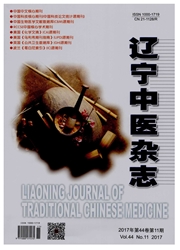

 中文摘要:
中文摘要:
目的:通过临床数据挖掘观察晚期大肠癌患者用药的聚集现象,客观地探索组方用药规律。方法:首先利用EXCEL统计数据库各味药的用药频次,对高频中药进行性味归经与药效频次的统计,然后将晚期大肠癌患者长期服用的基础方分别纳入扶正组与祛邪组,最后运用SPSS21导入数据,运用系统聚类法对高频中药进行聚类分析。结果:选取用药频次在前30的高频中药,按药性统计频次,由高到低依次为温性,寒性,平性,凉性;按药味统计频次,依次为甘味,苦味,淡味,辛味,酸味,涩味;按药物归经统计频次,依次为脾经、胃经、肺经、肝经、肾经等;按药效统计频次,依次为补虚药、理气药、消食药、利湿化痰药等;扶正组与祛邪组各形成三个聚类方,配伍以健脾益气,燥湿化痰为主。结论:治疗晚期大肠癌多以温性、归脾胃经、补虚药为主,以扶正抗癌为治疗原则。
 英文摘要:
英文摘要:
Objective:To explore the regularity oftraditional Chinese medicineformetastatic colorectal cancerpatients by using clinical data mining.Methods:Firstly,using EXCEL to count the frequency of traditional Chinese medicinebased on the clinicaldatabase.Select thehigh frequency traditional Chinese medicine to count the flavor and meridian tropismtogether with efficacy andfrequency.Then,the long-term use recipe of metastatic colorectal cancerpatients was included in Fuzheng group and Quxie group.Finally using SPSS 21 to import data,using clustermethod to analyze the high frequencytraditional Chinese medicine.Results:Select the first 30 of the high frequency traditional Chinese medicine.According to the medicinal to count frequency,from high to low is warm property of drug,cold property of drug,neutral property of drug and cool property of drug.According to the ingredients to count frequency is sweet,bitter,mild,pungent,sour andastringency.According to the meridian tropism to count frequency isspleen meridian,thestomachmeridian,the lung meridian,the liver meridian,the kidney meridian.According to the efficacy to count frequencyis Tonify deficiency medicine,Spleen medicine,Digestant drug,Phlegm dampness drug.The Fuzheng group and Quxie groupform three clusterings individually.The ompatibility give priority to Invigorating spleen and Supplementing Qi,Phlegm dampness.Conclusion:The treatment of metastatic colorectal cancer with warm property of drug,spleen or stomachmeridian,Tonify deficiency medicine.The main principle oftreatment formetastatic colorectal canceris strengthening the body resistance tocancer.
 同期刊论文项目
同期刊论文项目
 同项目期刊论文
同项目期刊论文
 期刊信息
期刊信息
